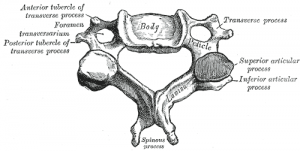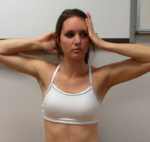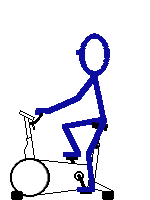Definition/Description
Cervical spinal stenosis is a narrowing of the spinal canal in the neck, mostly in adults 50 years and older, and can cause pain and other problems.[1] This can lead to squeezing or compressing of the nerve roots where they leave the spinal cord or it can damage the spinal cord itself.[2] These conditions are referred to as radiculopathy and cervical spinal myelopathy respectively.
Epidemiology/Etiology
Spinal stenosis occurs most commonly in either the lumbar or cervical regions of the spine. Abnormalities that can lead to stenosis are twice as likely to be seen on an MRI in patients over the age of 40;[3] however, even when such abnormalities exist stenosis may present without any signs or symptoms. In fact research has shown that degenerative changes that manifest in images or scans of the cervical region do not correlate to neck pain.[4]
There are two main types of spinal stenosis:[5]
- Primary: congenitally smaller than normal canal. Not very common, but usually leads to spinal stenosis in the middle of life.
- Acquired: result of disease or injury to the spine such as the causes listed below.
- Age related changes, which include: chronic degeneration, excessive growth of the bones such as osteophytes, destruction of the cartilage, and bulging of the disc.
- Osteoarthritis.
- Thickening of ligaments that connect the bones.
- Congenital factors such as craniodiaphyseal dysplasia, achondroplasia, and Paget’s disease of the bone.
- Spinal Tumors.
- Spinal injuries causing dislocations or fractures.
Examination/Diagnosis
A complete exam including medical history and a neurological screen is essential to determine whether neurological findings exist (either myelopathy or radiculopathy) and whether surgery or other conservative intervention is indicated.[3] Spinal stenosis can only be diagnosed with imaging, and MRI is the preferred imaging technique.[3]
The video below shows how to read an MRI of cervical stenosis.
Primary Complication
Cervical myelopathy is the most common problem that occurs as a result of spinal stenosis. The neurological symptoms associated with this pathology are usually the primary impetus for patients to seek care.
Treatment Options
Cervical lesions narrowing the spinal canal and affecting the spinal cord do not necessarily call for surgical treatment. In fact, 26% of asymptomatic older patients have cervical lesions affecting the spinal cord detectable by MRI.[7] If cervical spinal myelopathy (CSM) or radiculopathy do exist, treatment options are either a conservative approach or surgery.
Conservative Approach
Conservative treatment options for CSM include: immobilization with a cervical collar, NSAIDS and/or muscle relaxants, traction, cervicothoracic stabilization (strengthening of nuchal, upper quadrant, and scapula musculature), and avoidance of activities that cause stress to the cervical spine.[3]
Surgical Approach
Surgery may prevent the progression of myelopathy and improve the neurological deficits. There are many surgery options to consider based on patient presentation and severity. However, not enough prospective randomized trials have been done to demonstrate an absolute advantage or disadvantage of surgery.[3] To date, only poor quality evidence has been produced supporting the effectiveness of a surgical approach to relieve specific nerve impingement.[8] The goal of surgery is to decompress the spinal cord by removing any space occupying lesions, such as osteophytes or disk protrusions, and neutralize any instability.[3]
Minimally invasive surgery is becoming more advanced and offers many benefits over open surgery. The video below gives an insight into this. The cervical surgery for stenosis is similar to the outlined lumbar surgery.
Anterior Approach
By clearing out the disk via an anterolateral access, surgeons reach the spinal canal lateral to the neuroforamina through the intervertebral disk space. Once this is done, surgeons can resect vertebral disk protrusions and remove spondylophytes. The procedure decompresses the previously compressed spinal cord. This approach can also include fusion of vertebrae.
Indications
- Generally recommended for anterior space-occupying osteophyte or disc tissue lesions, or if the pathology is mono- or bi-segmental.
Types
- Intercorporal spondylodesis procedure: surgeons fuse successive vertebral segments of the cervical spine with short bone grafts.
- Corporectomy: the middle section of the vertebral body is removed in addition to adjoining vertebral discs and then replaced by implantation of either a bone graft or a cage.
- Monosegmental pathology: surgeons may insert an intervertebral disc prosthesis in order to maintain patients’ mobility and avoid future problems with adjacent segment instability. Advantages of this procedure have yet to be proven.
Advantages/Disadvantages
The advantage of the anterior approach is that it can be effective for correcting kyphosis.[3] The disadvantages are that long stretches of ventral osteophytes may have to be removed, risking damage to the spinal cord, and that the risk of fusion failure increases with number of segments treated.
Anterior Approach Video
Posterior Approach
Indications
- The goal is to indirectly decompress the spinal cord. Hypertrophic facets, thickened ligamentum flava, or even anterior space occupying lesions can be removed. Additionally, any instability can be stabilized with hardware or osteosynthesis.[3]
Types
- Laminectomy: originally the gold standard treatment of multilevel cervical myelopathy, laminectomy alone has fallen out of favour due to documented post-surgery complications.[8]
- Laminectomy with fusion: With the addition of posterior fusion, this procedure reduces kyphosis and segmental instability caused by removing posterior elements during laminectomy; however, it also leads to altered cervical biomechanics that cause degeneration of adjacent segments.[11]
- Laminoplasty: This technique aims to preserve motion but with less alteration to the natural biomechanics of the c-spine.[11] The spinal canal is widened by creating “gutters” in the laminae, and then pushing the spinous processes and more involved laminae toward the opposite side. Titanium miniplates are screwed in place to keep this widening open.[12]
Advantages/Disadvantages
- Originally, laminectomy was highly regarded because of its extensive decompression of the spinal cord,[11] but without fusion, it can result in postoperative kyphotic malposition due to lack of stability in the area.[3] Laminoplasty has the advantages of decreased blood loss, bone loss, less operative time and decreased risk of dura and spinal cord injury,[13] but it is contraindicated for patients with kyphosis and is associated with post-op mechanical neck pain.[11]
Minimally Invasive Spine Surgery (MISS)
The MISS technique implies less trauma to the soft tissue and the surgery to be performed in an outpatient setting. Following postoperative time in the outpatient recovery area, patients are discharged home the same day of their surgery.[14]
Advantages
- Smaller incision(s)
- Less blood loss
- Lower risk of muscle and soft-tissue damage
- Lower risk of infection
- Reduced postoperative pain
- Reduced pain medication use
- Faster recovery
I
The video short below shows in animation a artificial disc replacement technique
Combined Procedures
Combination of anterior fusion with posterior approach – the fusion rates are high for this procedure, but the surgery has a high rate of morbidity since it is a more extensive surgery.[3]
Possible Surgical Complications[3][16]
- Muscle weakness
- Neck pain and stiffness
- Deep infection
- Psuedomeningocele
- Closure of opened laminae
- Neurological deterioration
- Death
Physical Therapy Management
The type of physical therapy intervention for post-operative patients of the cervical spine depends on the type of surgical approach. Therapists should take into consideration:
- Anterior versus posterior approach
- Wound healing
- Signs of infection
- Physical and psychological condition of the patient[17]
- Patient motivation
- Specific goals
Post-surgical lumbar and thoracic spine interventions may be applicable to the cervical spine, but more research is needed to validate the effectiveness of these interventions.
Lumbar and Thoracic Interventions
There is insufficient research on specific structured exercise programs that are effective treatments after surgery of the cervical spine.[18] Research that showed the effectiveness for post-surgical intervention of the lumbar and thoracic spine involved the following interventions:[19]
- Obtaining normal range of motion (ROM) in the movements affected by each type of surgery
- Spine mobilization
- Flexibility in posterior paraspinals, upper traps, levator scapula, and scalenes
- Strength of upper quarter muscles and mid back
- Stabilization of deep neck flexors
- Posture and body mechanics
- Abdominal strengthening
- Aerobic/Cardiovascular conditioning
- Patient education
- Neural mobilization and stretches
Proposed Cervical Interventions
(J Rodeghero J and E Robertson, personal communication, 2008)
- ROM (as per specific protocols in regards to limitations) progressive to tolerance
- Stabilization with neuromuscular re-education for deep neck flexors
- Flexibility: posterior paraspinals, upper traps, levator scapulae, scalenes
- Strengthening of upper quarter muscles
- Mobility–manual therapy to cervico-thoracic joints (where appropriate)
- Aerobic conditioning program
- Cognitive behavioral therapy
- Patient education
- Activity modification
- Postural awareness
- Body mechanics for work or activities of daily living (ADLs)
- Home exercise program (HEP)
Recommended Intervention Timeline
(J Rodeghero J and E Robertson, personal communication, 2008)
4 weeks:
- Posture education
- Cervical stabilization in supine
- UE AROM as tolerated
- Cervical AROM as tolerated in pain-free ROM
- Gentle 2-finger isometrics
- Scapular retraction, shrugs, chin tucks
4-12 weeks:
- UE theraband strengthening
- Scapular retraction strengthening
- Light weight UE strengthening
- CV exercise
- Ergonomics education
- TENS and ice for pain
12-24 weeks:
- UE and LE weight training
- Theraband PNF
- Push-up progression
- Sit-up progression
- Work hardening
24+ weeks:
- Functional training
- Progressive weight training
- High impact aerobic activity
- May begin contact sports
Clinical Bottom Line
Although research exists regarding the different surgical approaches for cervical spinal stenosis, there is a lack of agreement about the optimal approach; even more lacking is high quality evidence supporting specific post-surgical physical therapy interventions.
References
- ↑ WebMd. ↑ 2.02.1 Mayo Clinic Staff. Spinal Stenosis. ↑ 3.003.013.023.033.043.053.063.073.083.093.103.11 Meyer F, Borm W, Thome C. Degenerative cervical spinal stenosis: current strategies in diagnosis and treatment. Dtsch Arztebl Int 2008;105(20):366-72.
- ↑ Guzman J, Haldeman S, Carroll L, Carragee E, Hurwitz E, Peloso P, Nordin M, et al. Clinical practice implications of the Bone and Joint Decade 2000-2010 Task Force on Neck Pain and Its Associated Disorders: from concepts and findings to recommendations. J Manipulative Physiol Ther 2009;32(2 Suppl):227-43.
- ↑ Ullrich PF. Cervical Stenosis with myelopathy. ↑ Donald Corenman M.D. How to read a MRI of cervical stenosis. Available from: ↑ Kadanka Z, Mares M, Bednarik J, Smrcka V, Krbec M, Chaloupka, Dusek L. Predictive factors for mild forms of spondylotic cervical myelopathy treated conservatively or surgically. Eur J Neurol 2005;12:16-24.
- ↑ 8.08.1 Carragee EJ, Hurwitz EL, Cheng I, Carroll LJ, Nordin M, Guzman J, et al. Treatment of neck pain: injections and surgical interventions: results of the Bone and Joint Decade 2000-2010 Task Force on Neck Pain and Its Associated Disorders. J Manipulative Physiol Ther 2009;32(2 Suppl):176-93.
- ↑ Mayo Clinic. Dr Matthew Neil. Available from: ↑ Corenman DS. Anterior Cervical Decompression and Fusion (ACDF) from www.neckandback.com Available from: ↑ 11.011.111.211.3 Woods B, Hohl J, Lee J, Donaldson W, Kang J. Laminoplasty versus laminectomy and fusion for multilevel cervical spondylotic myelopathy. Clin Orthop Relat Res 2011;469(3):688-95.
- ↑ Agrawal D, Sharma BS, Gupta A, Mehta VS. Efficacy and results of expansive laminoplasty in patients with severe cervical myelopathy due to cervical canal stenosis. Neurol India 2004;52(1):54-8.
- ↑ Luk KD, Kamath V, Avadhani A, Rajasekaran S. Cervical Laminoplasty. Eur Spine J 2010;19:347-8.
- ↑ Spine universe. ↑ Laser spine institute. Cervical spine disc replacement. Available from: ↑ Satomi K, Ogawa J, Ishii Y, Hirabayashi K. Short-term complications and long-term results of expansive open-door laminoplasty for cervical stenotic myelopathy. Spine J 2001;1:26-30.
- ↑ Sinikallio S, Aalto T, Koivumaa-Honkanen H, Airaksinen O, Herno A, Kröger H, et al. Life dissatisfaction is associated with a poorer surgery outcome and depression among lumbar spinal stenosis: a 2 year prospective study. Eur Spine J 2009;18(8):1187-93.
- ↑ Pastor D. Use of electrical stimulation and exercise to increase muscle strength in a patient after surgery for cervical spondylotic myelopathy. Physiother Theory Pract 2010;26(2):134-42.
- ↑ McFeely JA, Gracey J. Postoperative exercise programs for lumbar spine decompression surgery: a systematic review of the evidence. Physical Therapy Reviews 2006;11(4):248-62.
- ↑ Cervical spinal stenosis post surgery exercises. Available from: function gtElInit() { var lib = new google.translate.TranslateService(); lib.setCheckVisibility(false); lib.translatePage('en', 'pt', function (progress, done, error) { if (progress == 100 || done || error) { document.getElementById("gt-dt-spinner").style.display = "none"; } }); }



